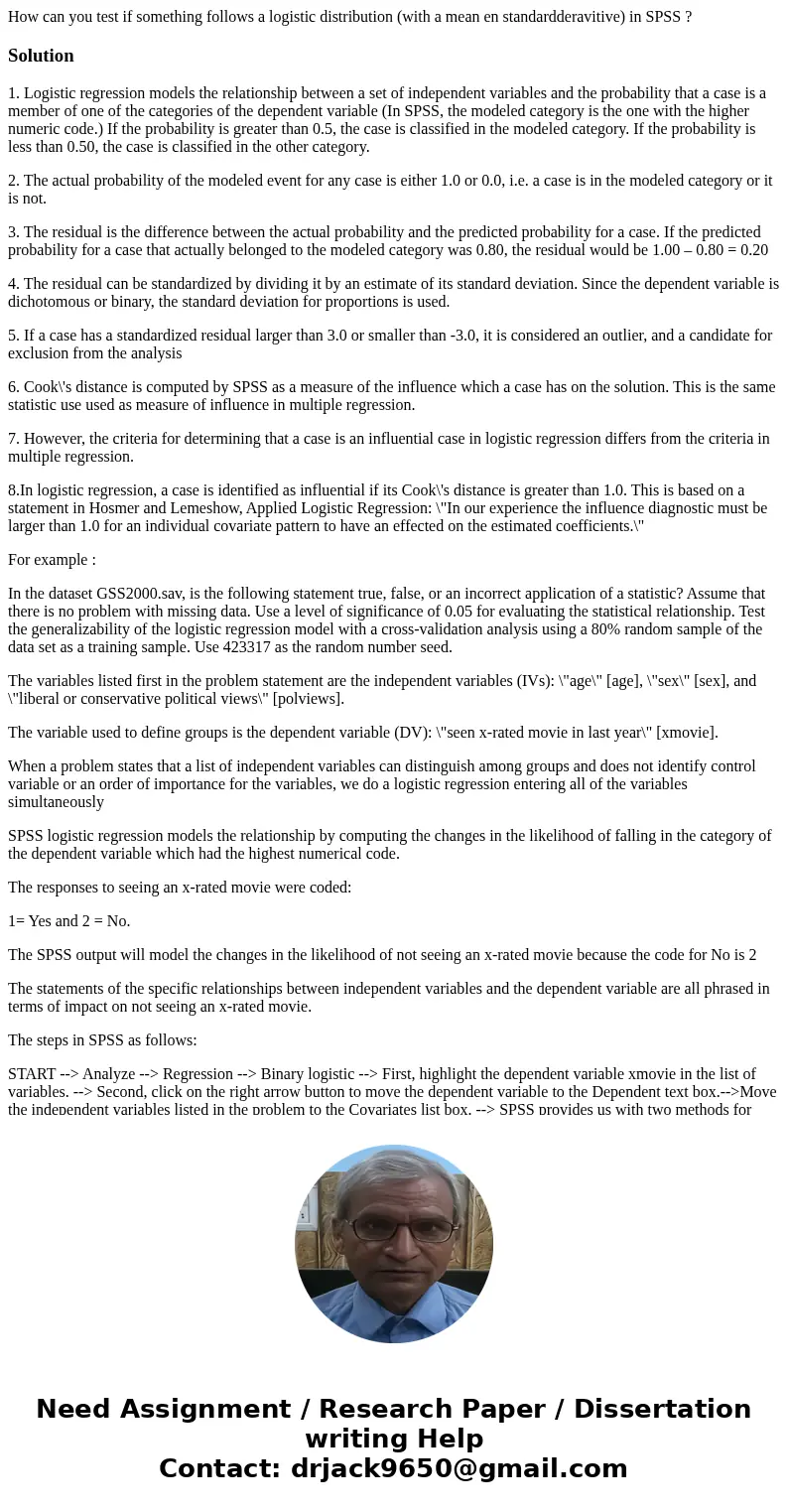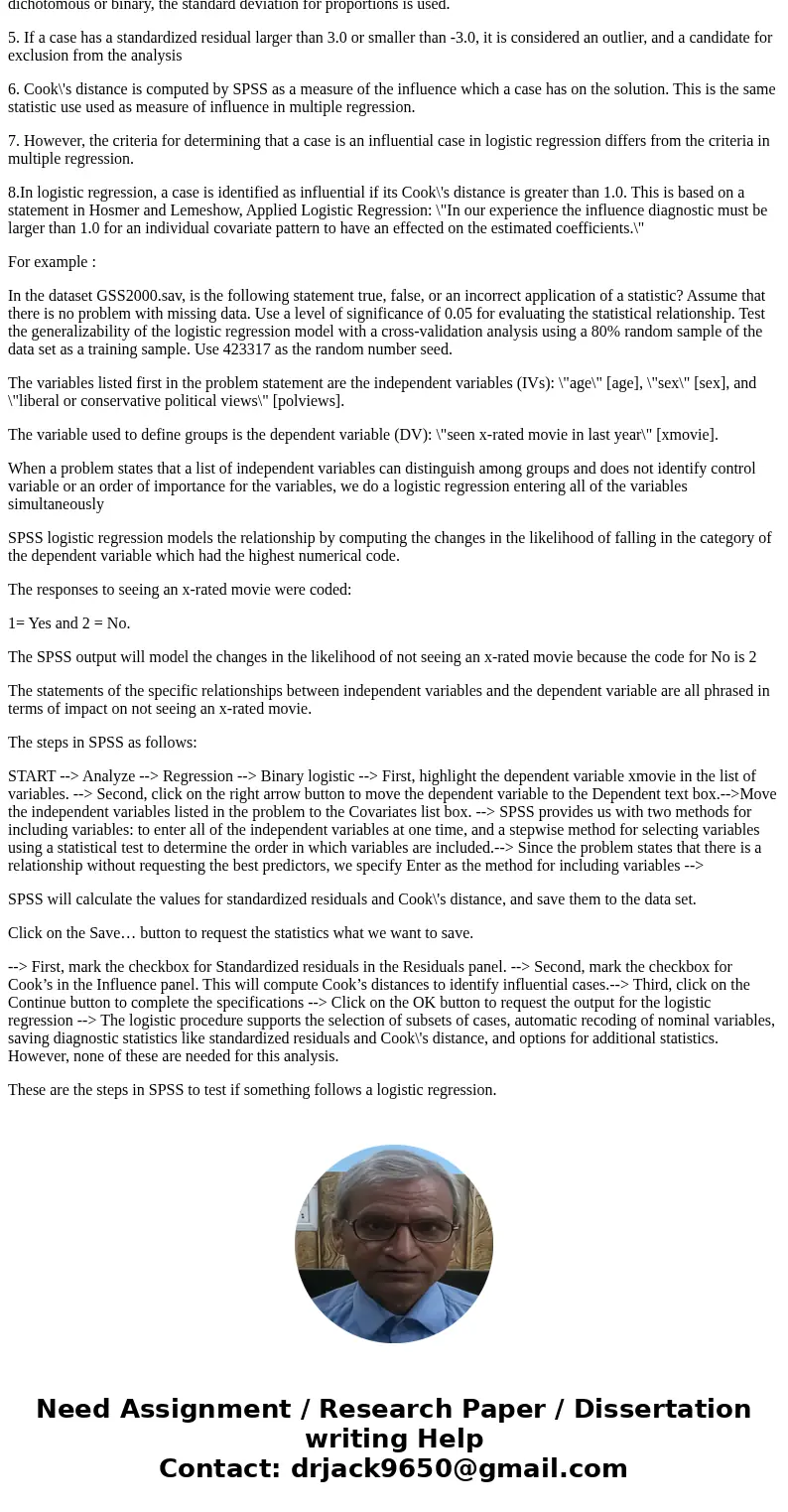How can you test if something follows a logistic distributio
How can you test if something follows a logistic distribution (with a mean en standardderavitive) in SPSS ?
Solution
1. Logistic regression models the relationship between a set of independent variables and the probability that a case is a member of one of the categories of the dependent variable (In SPSS, the modeled category is the one with the higher numeric code.) If the probability is greater than 0.5, the case is classified in the modeled category. If the probability is less than 0.50, the case is classified in the other category.
2. The actual probability of the modeled event for any case is either 1.0 or 0.0, i.e. a case is in the modeled category or it is not.
3. The residual is the difference between the actual probability and the predicted probability for a case. If the predicted probability for a case that actually belonged to the modeled category was 0.80, the residual would be 1.00 – 0.80 = 0.20
4. The residual can be standardized by dividing it by an estimate of its standard deviation. Since the dependent variable is dichotomous or binary, the standard deviation for proportions is used.
5. If a case has a standardized residual larger than 3.0 or smaller than -3.0, it is considered an outlier, and a candidate for exclusion from the analysis
6. Cook\'s distance is computed by SPSS as a measure of the influence which a case has on the solution. This is the same statistic use used as measure of influence in multiple regression.
7. However, the criteria for determining that a case is an influential case in logistic regression differs from the criteria in multiple regression.
8.In logistic regression, a case is identified as influential if its Cook\'s distance is greater than 1.0. This is based on a statement in Hosmer and Lemeshow, Applied Logistic Regression: \"In our experience the influence diagnostic must be larger than 1.0 for an individual covariate pattern to have an effected on the estimated coefficients.\"
For example :
In the dataset GSS2000.sav, is the following statement true, false, or an incorrect application of a statistic? Assume that there is no problem with missing data. Use a level of significance of 0.05 for evaluating the statistical relationship. Test the generalizability of the logistic regression model with a cross-validation analysis using a 80% random sample of the data set as a training sample. Use 423317 as the random number seed.
The variables listed first in the problem statement are the independent variables (IVs): \"age\" [age], \"sex\" [sex], and \"liberal or conservative political views\" [polviews].
The variable used to define groups is the dependent variable (DV): \"seen x-rated movie in last year\" [xmovie].
When a problem states that a list of independent variables can distinguish among groups and does not identify control variable or an order of importance for the variables, we do a logistic regression entering all of the variables simultaneously
SPSS logistic regression models the relationship by computing the changes in the likelihood of falling in the category of the dependent variable which had the highest numerical code.
The responses to seeing an x-rated movie were coded:
1= Yes and 2 = No.
The SPSS output will model the changes in the likelihood of not seeing an x-rated movie because the code for No is 2
The statements of the specific relationships between independent variables and the dependent variable are all phrased in terms of impact on not seeing an x-rated movie.
The steps in SPSS as follows:
START --> Analyze --> Regression --> Binary logistic --> First, highlight the dependent variable xmovie in the list of variables. --> Second, click on the right arrow button to move the dependent variable to the Dependent text box.-->Move the independent variables listed in the problem to the Covariates list box. --> SPSS provides us with two methods for including variables: to enter all of the independent variables at one time, and a stepwise method for selecting variables using a statistical test to determine the order in which variables are included.--> Since the problem states that there is a relationship without requesting the best predictors, we specify Enter as the method for including variables -->
SPSS will calculate the values for standardized residuals and Cook\'s distance, and save them to the data set.
Click on the Save… button to request the statistics what we want to save.
--> First, mark the checkbox for Standardized residuals in the Residuals panel. --> Second, mark the checkbox for Cook’s in the Influence panel. This will compute Cook’s distances to identify influential cases.--> Third, click on the Continue button to complete the specifications --> Click on the OK button to request the output for the logistic regression --> The logistic procedure supports the selection of subsets of cases, automatic recoding of nominal variables, saving diagnostic statistics like standardized residuals and Cook\'s distance, and options for additional statistics. However, none of these are needed for this analysis.
These are the steps in SPSS to test if something follows a logistic regression.


 Homework Sourse
Homework Sourse